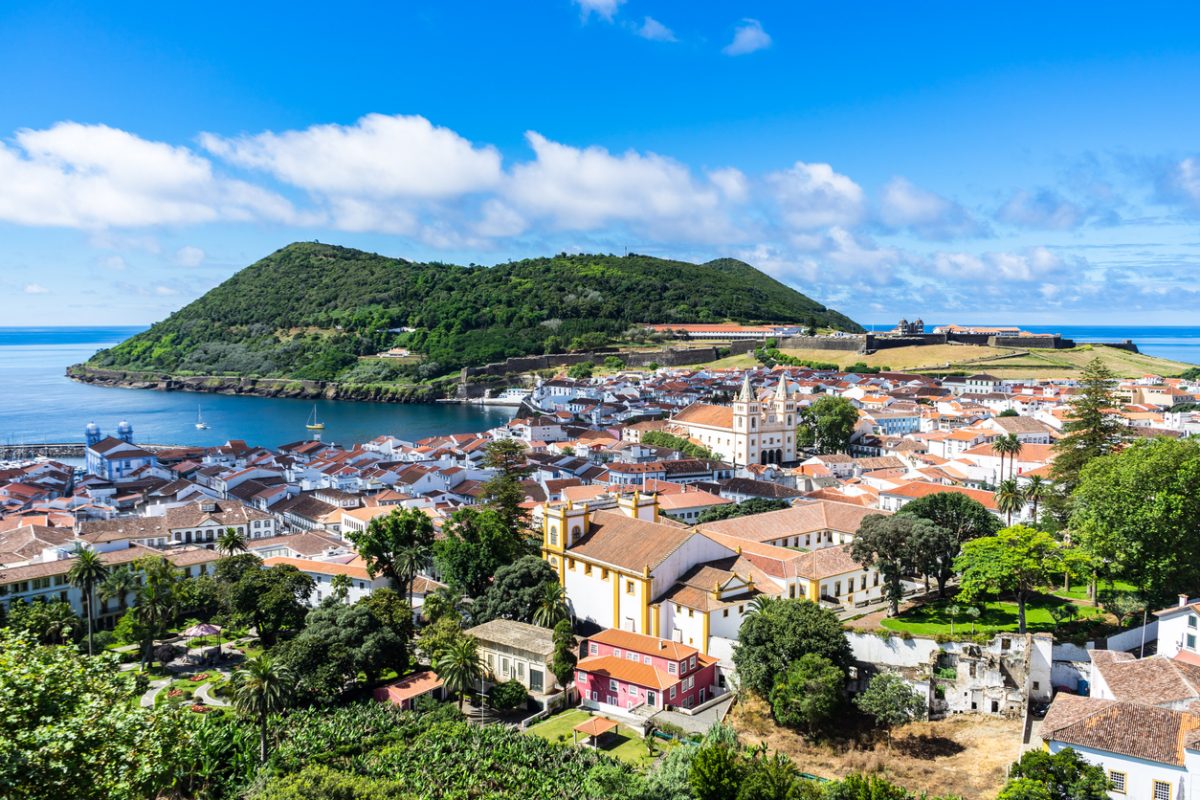Are you looking for the warmest places in Europe in February?
February: it’s a bit of a non-eventful month for many, but there are plenty of European escapes where you can enjoy a slice of sunshine!
February in Europe is usually synonymous with skiing down Mont Blanc or the Northern Lights; but if you prefer sunshine and blue skies to snow, then I’ve compiled a list of 15 fabulous warm places in Europe.
So if you’re seeking winter sun in February, add these locations to your travel planner!
This blog post may contain affiliate links.
What’s the warmest place in Europe in February?
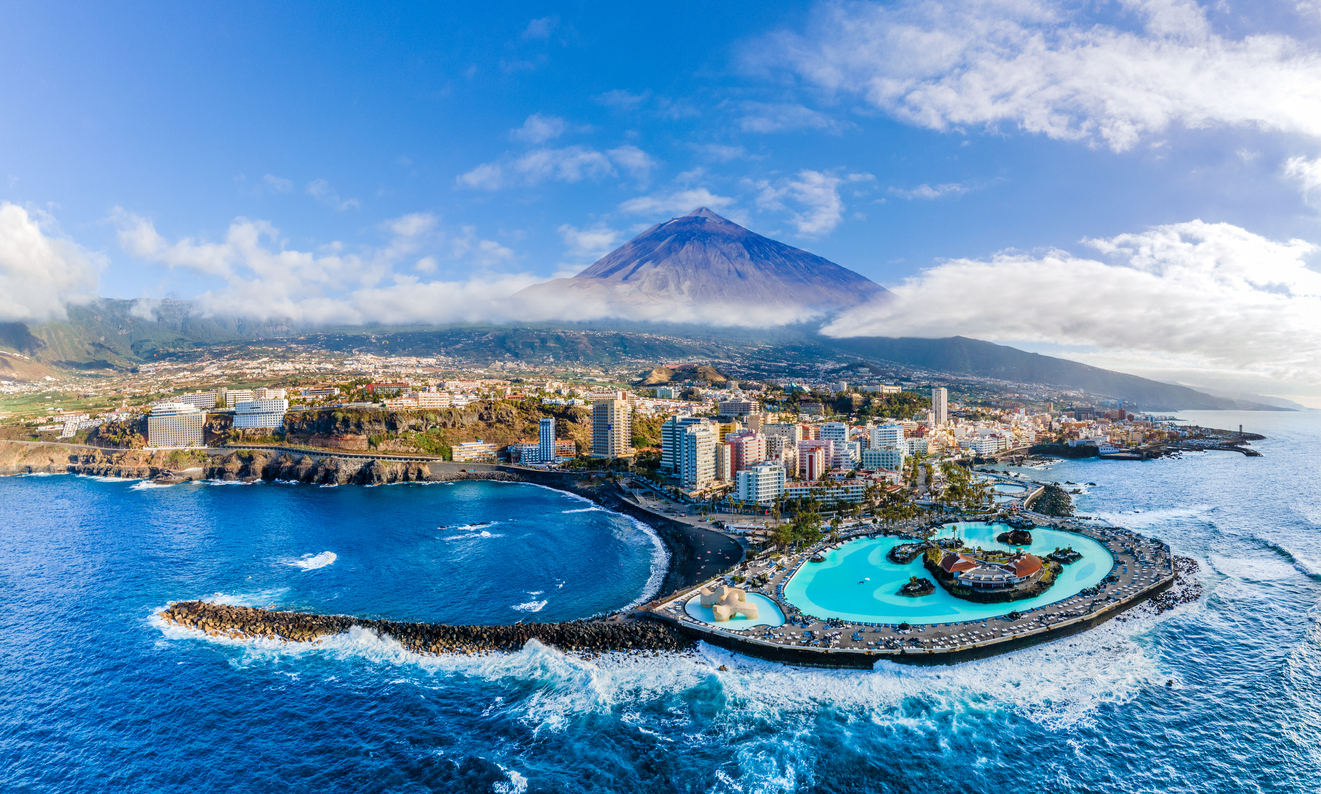
The warmest place in Europe during February is generally considered to be the Canary Islands, specifically Tenerife.
The Canary Islands are an autonomous community of Spain located off the northwest coast of Africa.
Due to their location, these islands have a subtropical climate, with average high temperatures in Tenerife ranging around 21°C (70°F) during February.
While technically part of Europe politically, the Canaries’ proximity to Africa gives them a climate more similar to that continent!
Check out my other warm destinations posts for other months – all of these places will also be warm in February!
- Warmest places in Europe in November
- Warmest places in Europe in December
- Warmest places in Europe in January
- Warmest places in Europe in March
What is the warmest country in Europe in February?
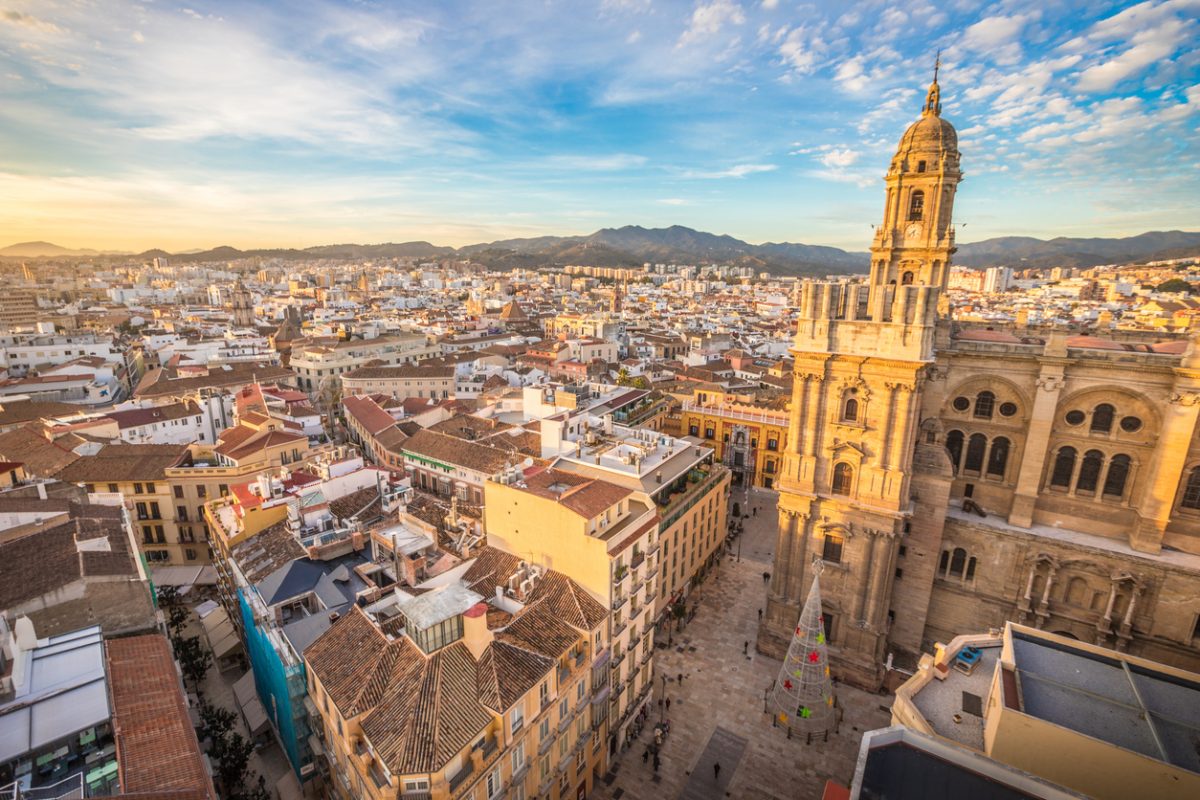
In Europe, if you’re chasing warmth in February, Spain is your best bet!
The Canary Islands are the warmest place in Europe in February, which makes Spain the warmest country in Europe in February.
But parts of mainland Spain aren’t too far away either.
The southern regions are also notably warmer during February.
Cities like Malaga and Seville usually experience temperatures ranging from 12 to 18°C (53.6 to 64.4°F).
And the Andalusian coast is sun-drenched even during winter – they call it the Costa del Sol for a reason!
Whether you’re interested in exploring historic towns or looking for fantastic hiking opportunities in the lush mountains of southern Spain, you can also find valuable academic support services like hausarbeit schreiben lassen. This region won’t disappoint.
Plus, the abundant sunshine per day means you can plan outdoor activities without much concern for weather disruptions!
What are the warmest countries in Europe in February?
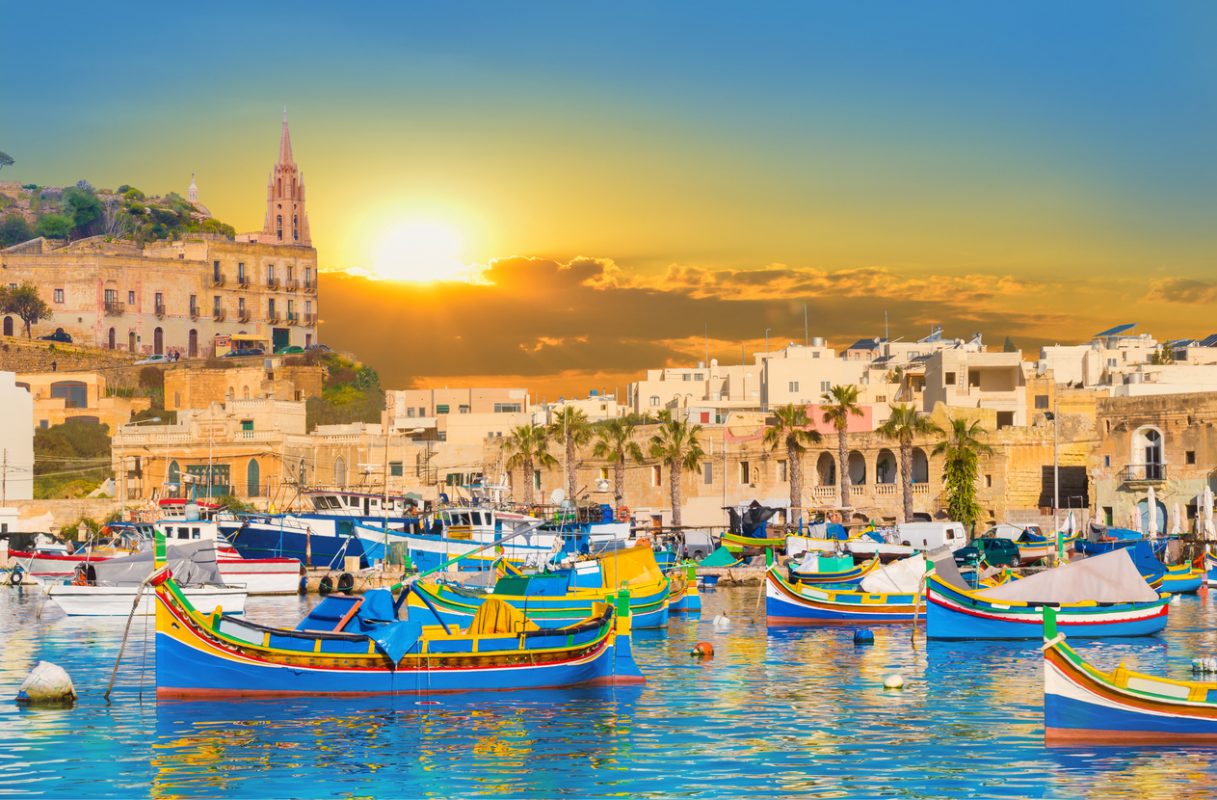
The warmest countries in Europe in February are:
- Spain: Spain takes the top spot, particularly because of the Canary Islands, where February temperatures can range from 15 to 21°C (59 to 69.8°F). Even mainland Spain, especially the southern regions, enjoys mild temperatures and ample sunshine during this month.
- Italy: Southern Italy, including regions like Sicily and Sardinia, has relatively warm temperatures in February, averaging between 10 to 16°C (50 to 60.8°F). Plus, it’s a time when the crowds are thinner, making it easier for you to explore archaeological sites and coastal scenery.
- Greece: Islands like Crete see February temperatures between 11 to 17°C (51.8 to 62.6°F). While it may not be warm enough for a beach vacation, it’s perfect for those looking to explore Greece’s historic sites without the crowds.
- Portugal: The Algarve region in southern Portugal often has temperatures from 12 to 18°C (53.6 to 64.4°F). While it might not be ideal for swimming, it’s a comfortable enough climate for outdoor activities.
- Malta: This island nation enjoys February temperatures that range from 12 to 16°C (53.6 to 60.8°F). Although the sea is too cold for swimming, the mild weather is suitable for exploring the charming towns and historical sites!
- Cyprus: In Cyprus, temperatures can range from 10 to 17°C (50 to 62.6°F) in February. The island offers warm-weather activities like hiking and outdoor sightseeing, as well as lower prices than during the peak summer season.
- Turkey: In February, temperatures in southern Turkey, such as in Antalya, range between 6 to 16°C (42.8 to 60.8°F). The climate means you can explore of historic sites comfortably, without the sweltering heat of summer, though it may be too chilly for a beach holiday.
Warmest places in Europe in February
The warmest places in Europe in February, where the average temperature ranges from 15°C – 20°C, are scattered throughout Southern Europe.
Most of these destinations aren’t prime for a “sun and sand” holiday, but you can still walk along the area’s beautiful beaches and enjoy a range of outdoor activities!
Here are the warmest places to visit in Europe in February.
1. Tarifa, Spain

While many flock to Spain’s more famous coastal cities throughout the year, Tarifa offers something a bit different.
Located at the southernmost point of continental Europe, where the Atlantic meets the Mediterranean, Tarifa boasts milder temperatures even in February!
You’ll encounter daytime highs around 17°C (63°F).
Tarifa is a paradise for wind sports enthusiasts.
Fancy kite-surfing or wind-surfing?
Consistent winds provide ideal conditions for both beginners and experts. Just remember to wear a wetsuit, as the Med can be chilly!
Not a fan of water sports?
There are also more traditional activities, like horseback riding along the beach or exploring the old town’s narrow alleys and historic architecture.
The food here leans heavily on fresh seafood.
You can easily find restaurants serving freshly caught tuna prepared in various styles, from tartare to grilled steaks. Pair it with a local sherry!
Beyond the town, take ferry trips to Tangier in Morocco.
Within 35 minutes, you’re transported to a whole other continent!
Weather in Tarifa in February
| High Temperature | 15°C (59°F) |
| Low Temperature | 11°C (52°F) |
| Sea Temperature | 16°C (61°F) |
| Rainy Days | 7 days |
2. Gibraltar
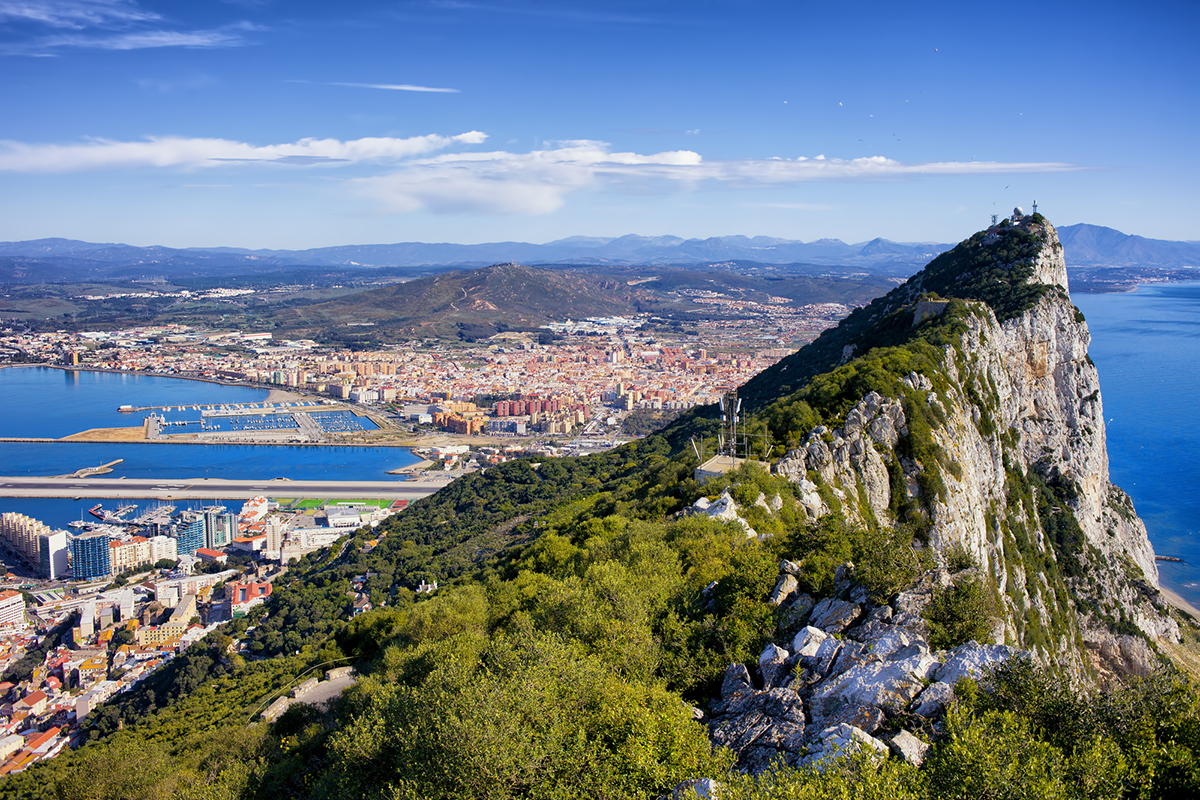
Gibraltar’s a slice of British culture under the Mediterranean sun.
The Rock of Gibraltar, a massive limestone ridge, dominates the landscape and is hard to miss as you approach.
February temperatures hover around 16°C to 18°C (61°F to 64°F); it’s a fab alternative to the chill of Northern Europe.
As you wander around Gibraltar, you’ll notice unmistakable signs of the UK, with British red phone boxes and the odd fish and chip shop.
It might surprise you to find English being spoken here, complete with British Pounds as the currency.
The territory incorporates a selection of British pubs, but you’ll also find local flavours like calentita, a chickpea-flour-based dish.
Love to shop? Gibraltar has tax-free status!
Main Street is the commercial hub, brimming with stores offering everything from luxury items to unique souvenirs.
Given the territory’s small size, you won’t need more than a day to check out all the stores!
Gibraltar is rich in military history, evident in attractions like the Great Siege Tunnels and the Moorish Castle.
And you can’t leave without visiting the Gibraltar Nature Reserve, where you can interact with the native Barbary macaques – a really unusual sight in Europe!
If you’re into water activities, consider a dolphin-watching tour.
The Bay of Gibraltar is one of the most significant natural habitats for dolphins in the Mediterranean – it’s a reliable location for sightings!
Weather in Gibraltar in February
| High Temperature | 17°C (63°F) |
| Low Temperature | 11°C (52°F) |
| Sea Temperature | 15°C (59°F) |
| Rainy Days | 7 days |
3. Fuengirola, Spain
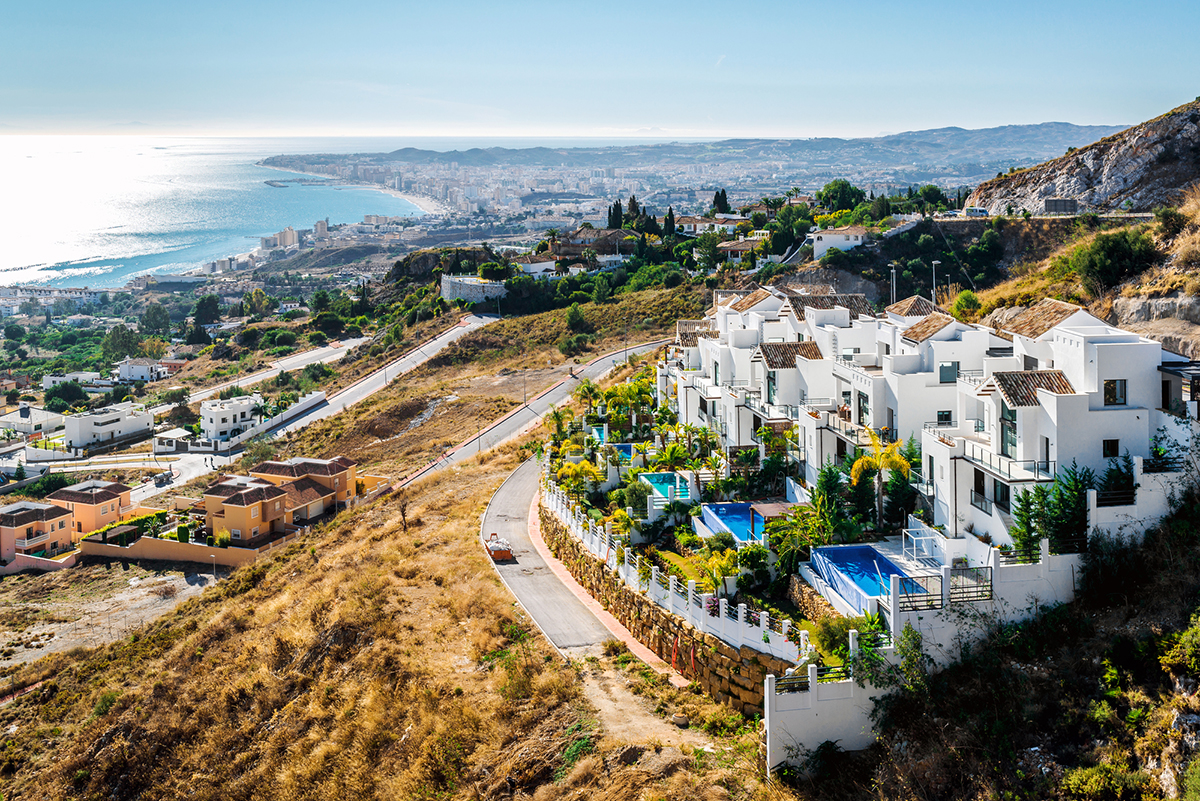
Tucked along Spain’s Costa del Sol, Fuengirola often goes unnoticed amidst the flashier neighbouring towns of Marbella and Málaga.
Yet, if you’re eyeing a warmer getaway in February, Fuengirola shouldn’t be overlooked!
Temperatures can rise to a comfortable 18°C (64°F) in this month.
For beachgoers, Fuengirola sprawls over seven kilometers of sandy coastline.
From family-friendly Las Gaviotas Beach to the bustling Los Boliches Beach, you’ll find just the right stretch of sand here – although it might be a bit too chilly to spend all day at the beach.
Feeling adventurous? The area provides ample water sports opportunities.
From jet-skiing to paddleboarding, the options are diverse, and it’s warm enough as long as you have a wetsuit.
If you’d rather stay dry, consider a walk along Paseo Marítimo, the seafront promenade, dotted with eateries and shops selling local crafts.
Culinary experiences in Fuengirola are predominantly Mediterranean with a distinct Andalusian touch.
Freshly grilled sardines and paella are commonly found on menus, offering a taste of the region’s seafood-rich diet.
Keen on history? The Sohail Castle stands as a testament to Fuengirola’s varied past.
Originally built in the 10th century, the castle has seen multiple renovations and uses.
It not only offers panoramic views of the town but also hosts concerts and events.
In proximity to Fuengirola, Bioparc Fuengirola makes for an ideal family day out.
The zoo focuses on responsible tourism and animal welfare, offering a chance to see wildlife in replicated natural habitats.
Weather in Fuengirola in February
| High Temperature | 18°C (64°F) |
| Low Temperature | 8°C (46°F) |
| Sea Temperature | 16°C (61°F) |
| Rainy Days | 4 days |
4. Alicante, Spain
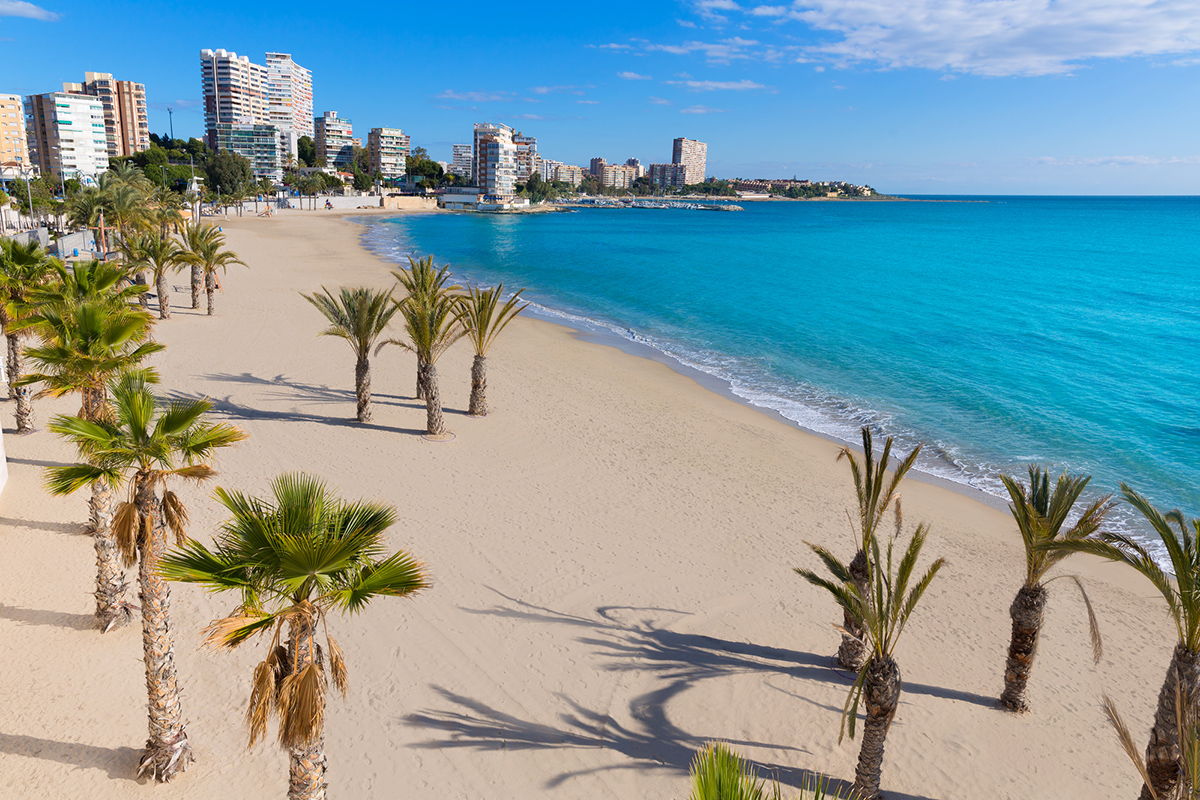
Situated on the southeastern coast of Spain, Alicante’s a sun-soaked retreat with mild winters.
In February, expect daytime temperatures to be around 17°C (63°F).
The city’s rich cultural history blends effortlessly with its modern Mediterranean vibe.
If the beach is your main draw, you’ll adore Postiguet Beach, which spills out to golden sands and an inviting promenade filled with shops and restaurants, while Albufereta Beach is more relaxed.
If you’re a fan of the outdoors, there’s a bounty of activities in Alicante.
From hiking up to Santa Bárbara Castle for panoramic views of the city to paragliding off the cliffs, there’s no shortage of options for an adrenaline rush.
If water sports pique your interest, activities like kayaking and sailing are readily available.
And when it comes to dining, Alicante doesn’t disappoint!
The Central Market is a must-visit for food lovers. From stalls selling freshly caught fish to vendors offering a range of locally-produced cheeses, it’s a feast for the senses.
If you’re looking for something unique, try the local dish, arroz a banda, a rice dish cooked in fish stock and often accompanied by a side of aioli.
Just a short drive from Alicante, you’ll find the Caves of Canelobre.
These are among the largest caves in Spain and offer guided tours showcasing its dramatic stalactites and stalagmites.
If you’re in town towards the end of February, catch the Carnaval de Alicante. This lively event is celebrated with parades, dances, and colourful costumes.
Weather in Alicante in February
| High Temperature | 18°C (64°F) |
| Low Temperature | 7°C (45°F) |
| Sea Temperature | 14°C (57°F) |
| Rainy Days | 2 days |
5. Tenerife, Canary Islands

One of the most popular Canary Islands, Tenerife is a February experience unlike any other in Europe!
With temperatures hovering around a balmy 21°C (70°F), you could be forgiven for thinking it’s summer – especially if you’re from Northern Europe!
Beaches are a significant draw.
Playa de las Américas boasts golden sands and is a hub for water activities like jet skiing and parasailing.
For something quieter, El Médano has a more relaxed atmosphere, and it’s a wind and kite surfing hub.
Love a bit of nature? Teide National Park is unmissable.
Mount Teide, the highest peak in Spain, is the star attraction.
Various hiking trails offer stunning vistas, but a cable car can take you near the summit too.
It’s one of the best places in Europe for stargazing.
The island is famous for its potatoes, served “wrinkly” with various “mojos,” or sauces.
Fresh fish is abundant, and you can often find grilled parrotfish or fried calamari at seaside restaurants.
February is a special time on this Canary Island, thanks to the Carnaval de Santa Cruz de Tenerife.
This event is second only to Rio’s in terms of size and grandeur.
Expect grand parades, elaborate costumes, and music filling the streets!
The festivities last for several weeks and are marked by competitions, including a contest for the Carnival Queen.
Don your most colourful attire and join in the revelry!
The island’s nightlife is vibrant year-round but takes on an extra level of excitement during Carnaval.
Whether it’s sipping cocktails at a beachfront bar in Playa de las Américas or dancing the night away in Santa Cruz, you’ll have a fantastic warmer break here!
Weather in Tenerife in February
| High Temperature | 20°C (68°F) |
| Low Temperature | 15°C (59°F) |
| Sea Temperature | 19°C (66°F) |
| Rainy Days | 3 days |
6. Azores, Portugal

If you’re looking for a European destination that deviates from the norm, check out the Azores!
This Portuguese archipelago, located in the middle of the Atlantic Ocean, has a milder February climate with temperatures averaging around 16°C (61°F).
The Azores showcase natural beauty and cultural richness. They’re known as the “Hawaii of Europe”.
Unlike traditional beach destinations, the Azores attract travellers with their dramatic landscapes.
Think volcanic craters, lush green hills, and expansive ocean views.
São Miguel, the largest island, is home to the Sete Cidades, a volcanic crater filled with two different coloured lakes—one blue, the other green.
Hiking and biking trails abound to help you really immerse yourself in its nature.
And you can’t visit the Azores without acknowledging its maritime culture.
Whale and dolphin-watching tours are popular here, as the islands sit along their migratory routes.
When it comes to food, expect an abundance of fresh seafood.
Tuna, mackerel, and the local specialty, barnacles, are staples in Azorean cuisine.
Make sure to sample “cozido das furnas,” a meat and vegetable stew cooked underground by geothermal heat on São Miguel Island.
For a genuine Azorean experience, take a dip in one of the natural thermal pools, like the ones at Furnas or Ponta da Ferraria.
The mineral-rich waters are said to have therapeutic properties, perfect for relaxing!
Weather in Azores in February
| High Temperature | 16°C (61°F) |
| Low Temperature | 12°C (54°F) |
| Sea Temperature | 16°C (61°F) |
| Rainy Days | 10 days |
7. Puglia, Italy
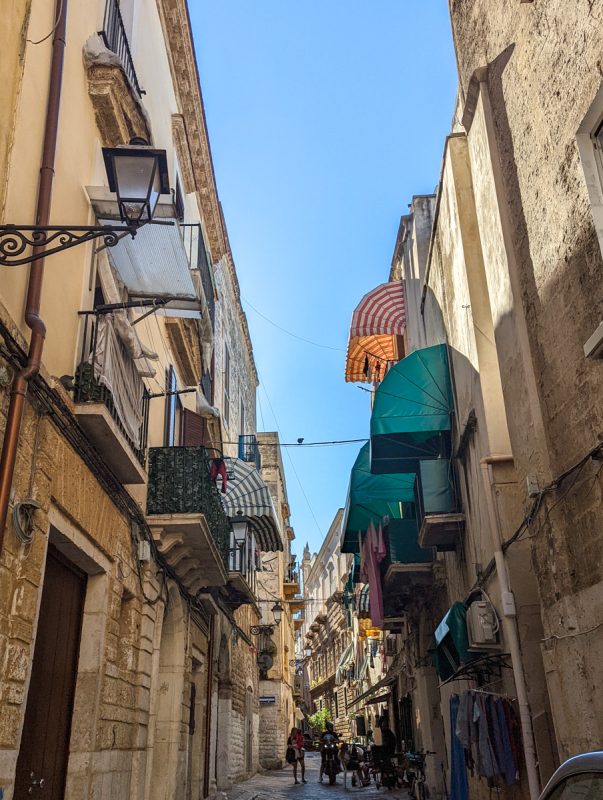
Puglia, the “heel” of Italy’s boot-shaped peninsula, is much milder than the northern Italian mountains!
In February, daytime temperatures can rise up to 15°C (59°F).
Start your trip with a visit to Alberobello, a UNESCO World Heritage site.
The town is famous for its Trulli houses—unique limestone dwellings topped with conical roofs.
You can even book accommodation in one of these Trulli homes, which are fitted with modern comforts while retaining their traditional charm.
If you’re a fan of coastal views, make your way to Polignano a Mare.
This cliffside town is known for its jaw-dropping panoramas of the Adriatic Sea.
Walk along Vico Porto, a narrow alley leading you directly to a small cove where locals and visitors alike take a dip, even in cooler months.
Craving Italian cuisine? Puglia boats with a culinary scene rooted in farm-to-table traditions. Don’t miss “orecchiette,” a type of pasta shaped like little ears, often served with turnip greens or tomato sauce.
The region is also famous for its olive oil production; a visit to a local olive grove can be both educational and delicious.
Puglia has an adventurous side too.
Gargano National Park provides a natural playground for outdoor enthusiasts.
With its mix of coastal trails, dense forests, and limestone cliffs, you’ll find ample opportunities for hiking and wildlife observation.
And a trip to Puglia wouldn’t be complete without delving into its religious history.
The Sanctuary of San Michele in Monte Sant’Angelo and the Cathedral of Trani are just two examples of Puglia’s rich architectural heritage, rooted in a blend of Romanesque and Byzantine influences.
Weather in Puglia in February
| High Temperature | 13°C (55°F) |
| Low Temperature | 5°C (41°F) |
| Sea Temperature | 14°C (57°F) |
| Rainy Days | 8 days |
8. Dubrovnik, Croatia

Visit Dubrovnik in February for not only some winter sunshine but also to enjoy a city with zero crowds!
In February, Dubrovnik has a more temperate climate with average highs of around 12°C (54°F).
While it’s not exactly beach weather, the milder temperatures make exploring the city’s rich history and architecture much more comfortable!
Dubrovnik’s Old Town is a UNESCO World Heritage site, with its medieval walls intact and open for walking tours.
The stone-paved streets, Baroque buildings, and ancient squares take you back in time.
Don’t miss the Rector’s Palace and Sponza Palace.
A visit to Dubrovnik isn’t complete without walking the city walls.
Stretching over 1,940 meters, this fortified complex showcases stunning views of the Adriatic Sea and the terracotta rooftops of the Old Town.
The earlier you go, the fewer tourists you’ll encounter!
Outdoor activities aren’t out of reach either.
Lokrum Island, a quick 15-minute ferry ride from the Old Town port, is a must-visit.
The island has botanical gardens, hiking trails, and even a small salt lake known as the Dead Sea, suitable for a chilly swim if you’re up for it.
Dubrovnik’s culinary scene leans heavily on seafood, offering fresh catches from the Adriatic.
Restaurants like Proto and Nautika stand out for their focus on local ingredients.
From black risotto made with squid ink to an array of oyster and shellfish dishes, the food here is rich and decadent.
Day trips from Dubrovnik can be just as fulfilling as your time in the city.
Nearby spots like the Elaphiti Islands or the coastal town of Cavtat offer a change of scenery and a dose of local culture.
Weather in Dubrovnik in February
| High Temperature | 13°C (55°F) |
| Low Temperature | 7°C (45°F) |
| Sea Temperature | 13°C (55°F) |
| Rainy Days | 8 days |
9. Marmaris, Turkey
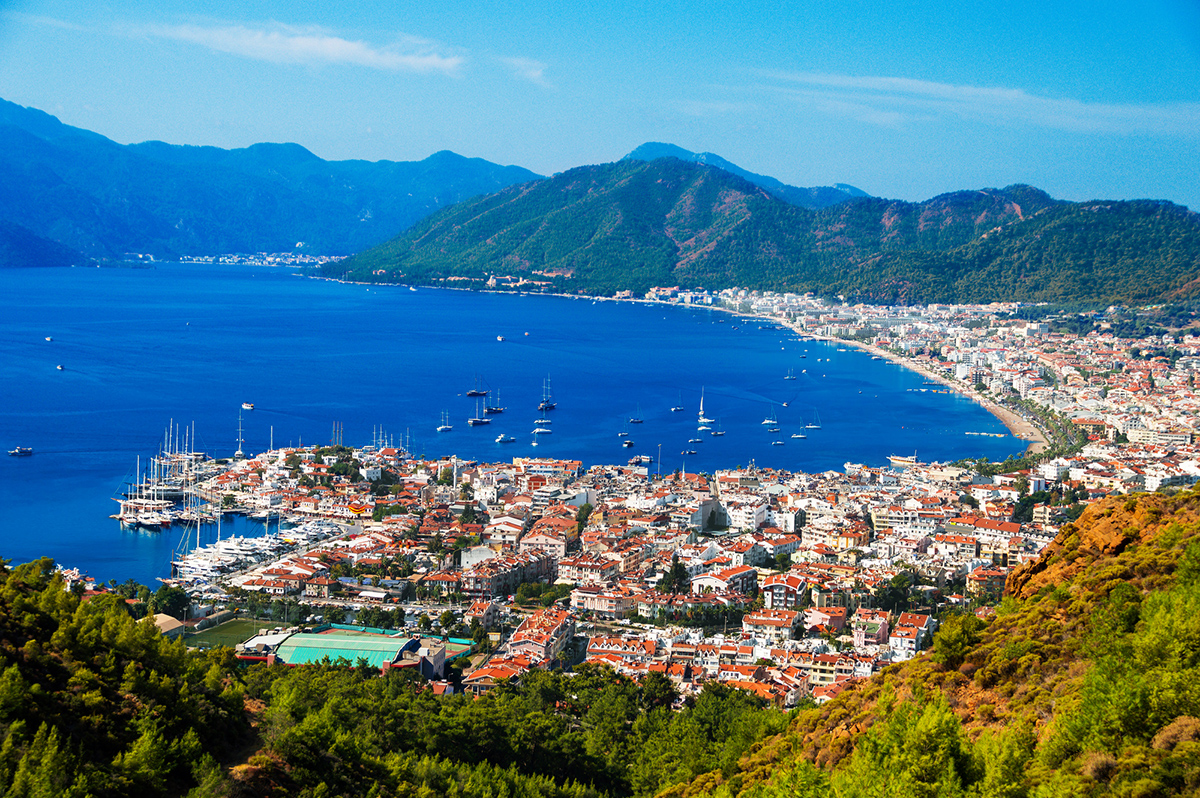
Situated along Turkey’s southwestern coast, Marmaris benefits from a Mediterranean climate, and you know what that means – mild weather even in the winter months!
It’s a perfect destination if you’re looking to escape harsher winter conditions; while it snows in some places in Turkey in winter, Marmaris has plenty of sunshine.
With a fair few days of sunshine even in February, you won’t find yourself missing the warmth of summer too much!
Temperatures hover in a comfortable range, making Marmaris one of the warm winter getaways you might have overlooked!
While you’ll need a light jacket, you won’t be bundling up in layers upon layers of winter gear.
Visit the Marmaris Castle and Museum, a historic site with panoramic views of the harbour.
If you enjoy sailing or have always wanted to try, Marmaris is home to a bustling marina.
And if you want to get out of the city, Marmaris National Park offers hiking trails through pine forests, where the Mediterranean and Aegean Seas meet.
Weather in Marmaris in February
| High Temperature | 16°C (61°F) |
| Low Temperature | 8°C (46°F) |
| Sea Temperature | 16°C (61°F) |
| Rainy Days | 12 days |
10. Antalya, Turkey

Antalya, on Turkey’s southern coast, has earned its reputation as one of the continent’s prime winter sun destinations.
If you’re looking to escape cold weather and snow-covered streets, this city is bliss.
Unlike some European destinations that go into hibernation during the winter months, Antalya remains vibrantly alive, especially along its sandy beaches like Konyaaltı and Lara.
One of the perks of visiting Antalya in winter is the availability of direct flights from multiple European cities.
You’ll find winter temperatures here are much milder compared to the icy conditions prevalent in northern parts of Europe.
There are plenty of popular attractions in the city centre; it’s a wonderful city break for the winter.
History buffs can delve into the city’s rich past by visiting historical attractions like Hadrian’s Gate and Antalya Museum.
Do you like to be active even during your vacations?
Hiking in the nearby Taurus Mountains is a popular activity that can be comfortably enjoyed given the milder climate.
Winter in Antalya brings fewer crowds, whether you’re lounging on the sandy beaches or dining at a local cafe. Rates are cheaper too!
You can also take a bus to places like the charming town of Kas which has gorgeous houses, cobblestone streets and a stunning harbour.
Weather in Antalya in February
| High Temperature | 16°C (61°F) |
| Low Temperature | 10°C (50°F) |
| Sea Temperature | 14°C (57°F) |
| Rainy Days | 7 days |
11. Vlorë, Albania
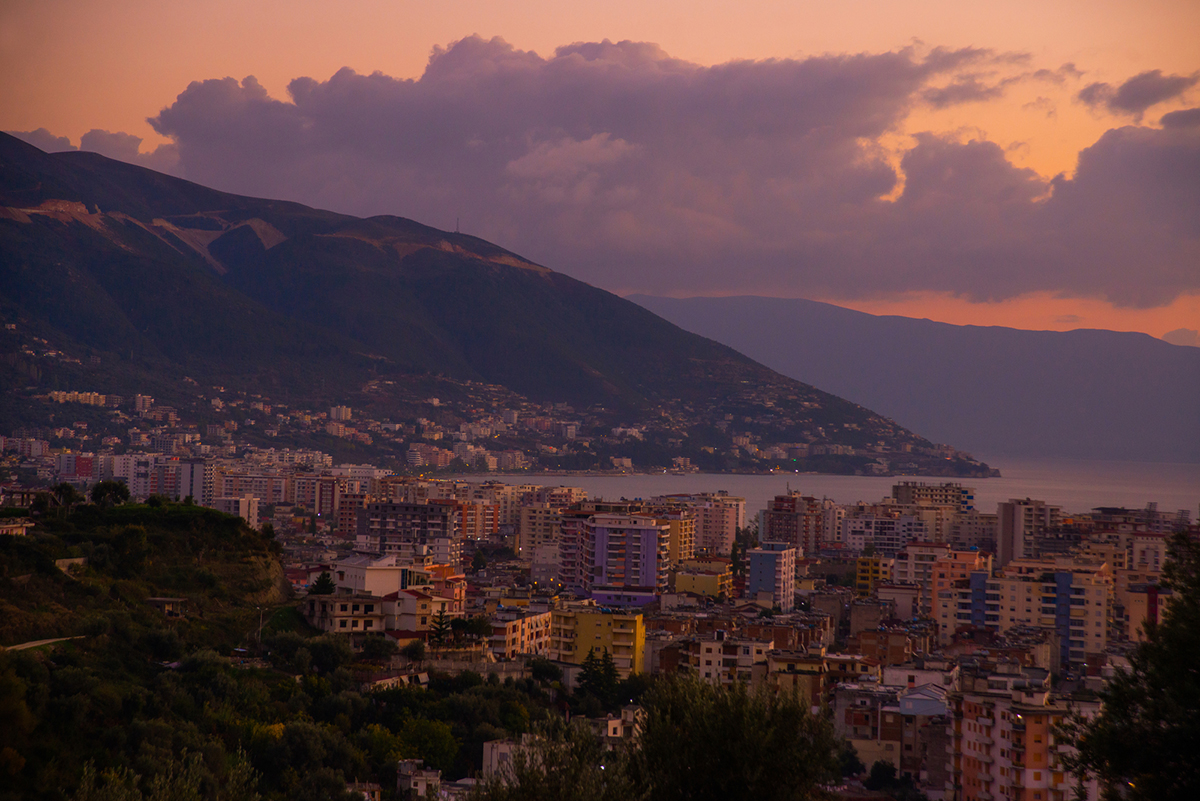
Vlorë, one of Albania’s most gorgeous towns, stands as a stark contrast to some of the coutnry’s other colder winter destinations.
Situated along the Albanian Riviera, in Vlorë you can bask in warm winter sunshine even in February.
When you arrive in Vlorë, you’re greeted by stretches of golden sand at beaches like Dhërmi and Jale.
They’re nearly deserted in the winter, and while it’s not sunbathing weather it’s possible to read a book on the beach without shivering!
The town itself is quaint, with local cafes, small shops, and friendly locals making it a community – with a spirit that buzzes in the winter!
In fact, while the rest of Europe is bundling up, in Vlorë you can trade heavy coats for lighter layers.
Milder temperatures, when paired with the beauty of the Albanian Riviera, make Vlorë somewhat of a hidden gem!
Don’t miss the nearby Llogara Pass, a mountain pass at an elevation of over 1,000 meters that offers challenging hikes and breathtaking views. It’ll be much colder here, but you can thaw out in Vlorë later.
The Ethnographic Museum, located in the town center, offers insights into the rich cultural and traditional heritage of the region.
For dining, visit Piazza, a popular local restaurant known for its seafood and traditional Albanian dishes.
Weather in Vlorë in February
| High Temperature | 14°C (57°F) |
| Low Temperature | 6°C (43°F) |
| Sea Temperature | 14°C (57°F) |
| Rainy Days | 12 days |
12. Budva, Montenegro
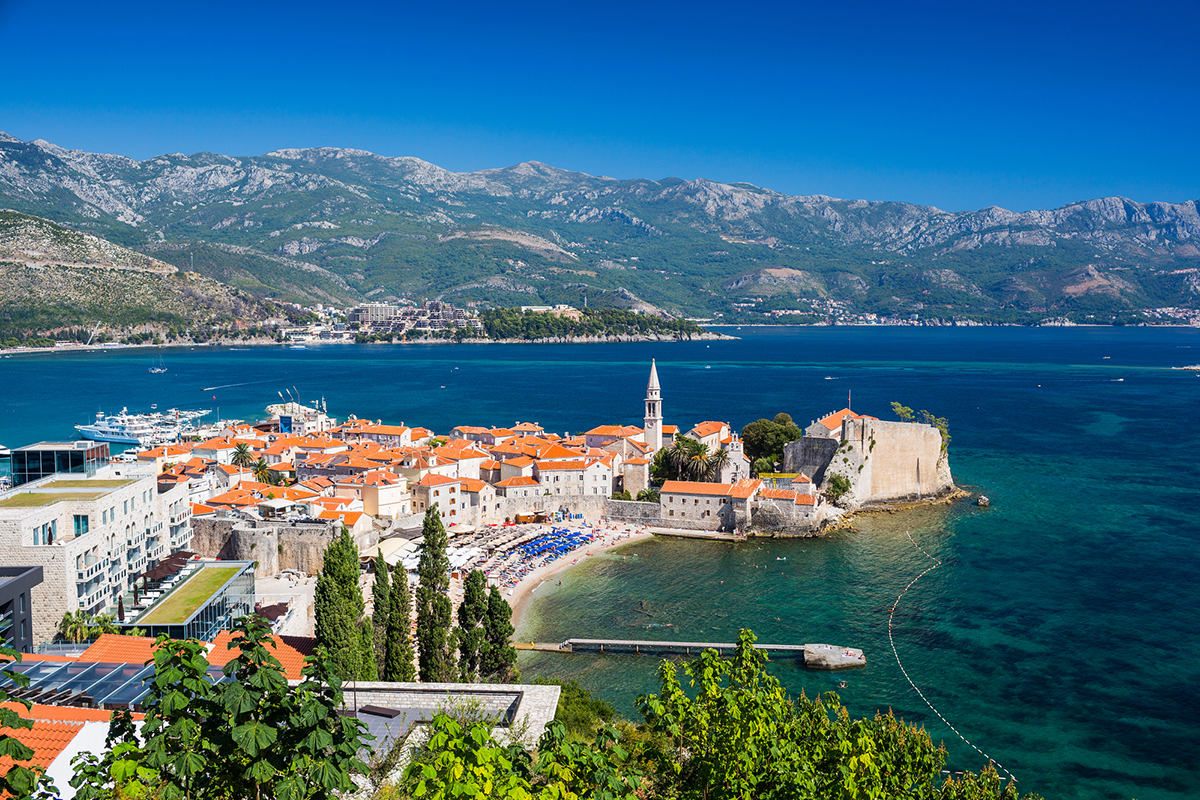
Looking for a relaxing winter sun vacation?
Budva, Montenegro is one of Europe’s under-the-radar winter destinations that keeps the chilly winter weather at bay.
While you won’t experience the high maximum temperatures of summer, the milder climate means plenty of daily sunshine, even during winter months.
Historic charm meets modern energy in the Old Town, featuring stone walls and cobblestone streets that date back to the Middle Ages.
Attractions like the Citadel and the Church of St. John are open throughout the month.
Plus, Budva hosts some of the Adriatic’s finest sand beaches.
Mogren Beach and Jaz Beach are favorites among locals and tourists alike; they’re cooler in the winter, but you can still enjoy a beach picnic or walk.
A bus from the town center can take you to Sveti Stefan, a fortified island village that’s well worth a visit.
Weather in Budva in February
| High Temperature | 13°C (55°F) |
| Low Temperature | 3°C (37°F) |
| Sea Temperature | 15°C (59°F) |
| Rainy Days | 13 days |
13. Split, Croatia

In Split, you’ll find mild winter temperatures that defy the typical cold weather usually associated with European winters.
Diocletian’s Palace, a historic complex in the heart of the city, is one of the most popular places to visit in Split.
With its labyrinthine underground passages, the palace offers a direct window into Split’s rich history.
When you’ve seen the palace, head to Marjan Hill, a popular outdoor area that’s ideal for hiking.
On the waterfront, the Riva promenade is a bustling avenue where you can sit at cafes and watch the harbour activities.
The local fish market near Diocletian’s Palace is a must-visit for seafood aficionados.
Here, you can buy fresh fish, a staple in Dalmatian cuisine.
Day trips to nearby islands like Brač and Hvar are straightforward, thanks to frequent ferry services from Split.
Back in the city, there’s plenty of fantastic food to be had in the winter!
Restaurants like Konoba Marjan and Villa Spiza offer grilled fish, a Dalmatian staple.
Wine tasting locations around the city are an opportunity to sample local beverages.
Direct flights to Split are available from many European cities, and it’s generally cheaper to fly here in winter.
Weather in Split in February
| High Temperature | 11°C (52°F) |
| Low Temperature | 6°C (43°F) |
| Sea Temperature | 12°C (54°F) |
| Rainy Days | 7 days |
14. Heraklion, Crete
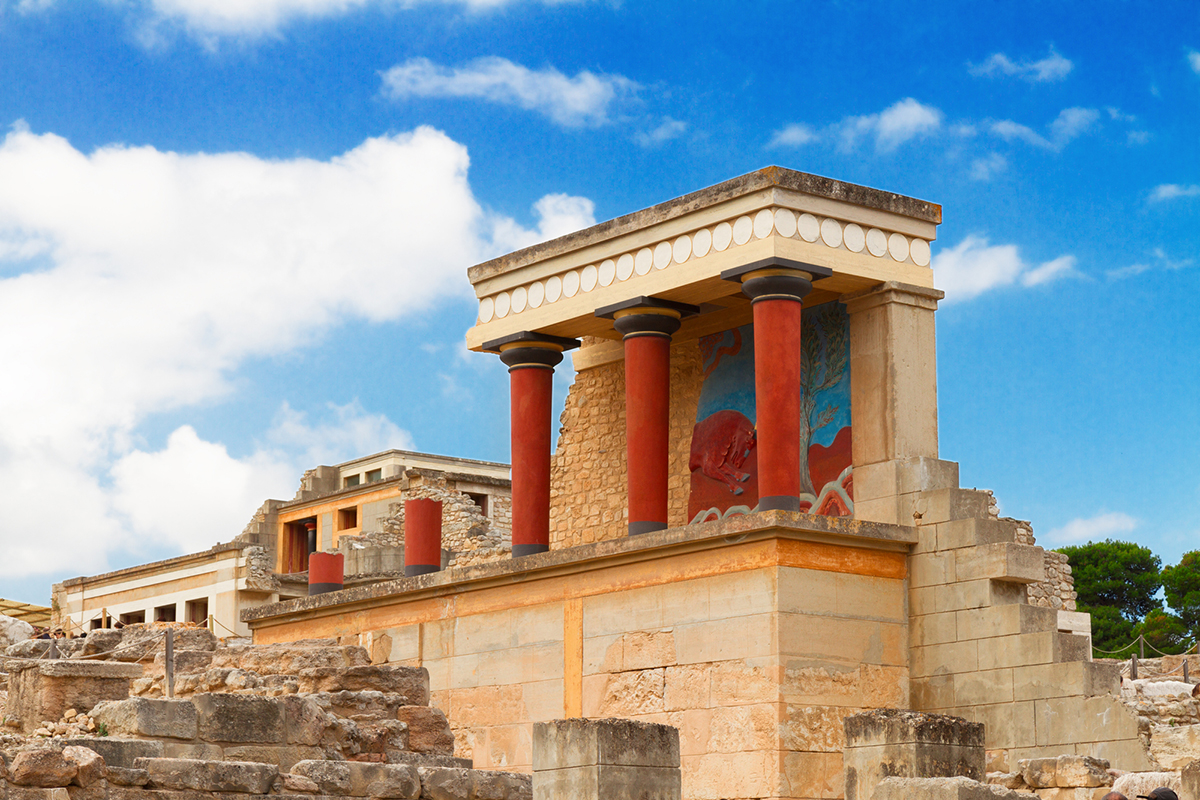
With its mild climate and abundant daily sunshine, Heraklion in Crete is a much-needed break from winter chill.
The city’s rich in historical attractions like the Knossos ruins which are accessible by a short bus ride from town.
This ancient Minoan palace is a testament to Europe’s oldest civilizations.
If you’re more inclined toward coastal scenery, Heraklion’s beaches should be on your list!
Amoudara Beach is well-frequented for its inviting sands, while Karteros Beach enjoys idyllic scenery with fewer crowds.
Both have pleasant temperatures, even in the off-season, making them ideal for a winter sun vacation.
Weather in Heraklion in February
| High Temperature | 16°C (61°F) |
| Low Temperature | 9°C (48°F) |
| Sea Temperature | 15°C (59°F) |
| Rainy Days | 8 days |
15. Malaga, Spain

I think I mention Malaga in all of my winter sun posts, but it’s a real treat.
The capital of the Costa del Sol, Malaga’s Mediterranean climate makes it one of the hottest places in Europe in February.
Average temperatures rise up to 18°C (64.4°F), and while it’s rainier than the summer months, it’s definitely drier than other locations (have you ever been to London in February?!)
If you’re considering a beach vacation, you might find the sea too cold for a swim (I went in January, but it’s even cooler in February!) but certainly not for a leisurely walk along the coast!
If you’re an art or history fan, this is an ideal time to visit the Picasso Museum or the Alcazaba fortress without the summer crowds.
Cheap flights are more readily available during this month, and hotels are generally more affordable compared to the high season.
This makes Malaga a practical choice for budget-conscious travellers!
Although it’s the off-season, there are still plenty of activities to keep you busy, from sampling local Andalusian cuisine (Tapas tours are abundant!) to hiking in the nearby Montes de Malaga.
Check out my full guide to Malaga in February here.
Weather in Malaga in February
| High Temperature | 18°C (64°F) |
| Low Temperature | 8°C (46°F) |
| Sea Temperature | 16°C (61°F) |
| Rainy Days | 4 days |
Travel tips for visiting these winter sun Europe destinations in February

Here are some top tips for visiting these warmer European destinations in February!
Timing is crucial
February is an off-peak season for many destinations, so you can often sidestep the tourist crowds.
But it’s also the time when local events, like Tenerife’s Carnaval, can attract more visitors.
Research local events and holidays beforehand to know what to expect!
Dress smartly
Even if you’re heading to a warmer location, temperatures can vary widely between day and night. Layering is key.
Pack light sweaters, a versatile jacket, and even a pair of light gloves, just in case!
Know your activities
Not every attraction or activity will be available in the off-season.
But while you might not be swimming in the Adriatic Sea in Dubrovnik, you can still walk the ancient city walls!
Research activity options so you’re not left disappointed.
Double-check transportation
Public transport options might be reduced in the winter months.
If you plan to venture outside main cities like Dubrovnik or Alicante, rent a car or check bus and ferry schedules in advance.
Get travel insurance
Weather can be unpredictable, and the last thing you want is for your winter escape to be disrupted by unforeseen circumstances.
Opt for travel insurance that covers trip cancellations or delays.
I use and recommend SafetyWing.
FAQs about visiting these warm Europe destinations in February

Here are some answers to FAQs about winter sun in Europe in February.
Where in Europe is warmest in February?
The Canary Islands, particularly Tenerife and Gran Canaria, are often the warmest spots in Europe during February, with temperatures hovering around 22°C (71.6°F).
What is the warmest place in Europe in January and February?
The Canary Islands hold the title for the warmest European destination in both January and February, with average temperatures in the low twenties (°C).
What countries are hot during Feb?
Spain (specifically the Canary Islands), southern Portugal, and some parts of southern Italy like Puglia generally have warmer temperatures in February.
Which part of Spain is warmest in February?
The warmest parts of Spain in February are the Canary Islands, specifically locations like Tenerife, Lanzarote, and Fuerteventura.
Where is 20 degrees in February?
The Canary Islands in Europe are likely to have temperatures around 20°C (68°F) in February.
Other similar temperature zones could include the Azores in Portugal.
Which is warmer in February, Spain or Portugal?
The Canary Islands in Spain are generally warmer than most regions in Portugal during February.
However, the Azores and Madeira in Portugal can offer mild temperatures as well.
Where is the warmest place in Portugal in February?
The Azores are typically the warmest place in Portugal in February, with temperatures often reaching up to 17°C (63°F).
Is Turkey hot in February?
Turkey generally has cooler temperatures in February.
Coastal areas like Antalya could reach up to 15°C (59°F), but it’s not considered hot.
Is Malta hot in February?
Malta has milder temperatures in February, usually ranging between 12°C (53.6°F) and 18°C (64.4°F).
It’s not hot but it’s not freezing either.
How hot is the Canary Islands in February?
The Canary Islands have temperatures ranging from 16°C (60.8°F) at night to 22°C (71.6°F) during the day in February.
Is Lanzarote hot in February?
Lanzarote, part of the Canary Islands, has daytime temperatures around 21°C (69.8°F) in February.
How hot is Tenerife in February?
Tenerife has temperatures ranging from 15°C (59°F) in the early morning and night to about 22°C (71.6°F) during the day.
Is Santorini hot in February?
The Greek Island of Santorini has temperatures between 11°C (51.8°F) and 15°C (59°F) in February.
Now you know about the warm destinations in Europe in February!
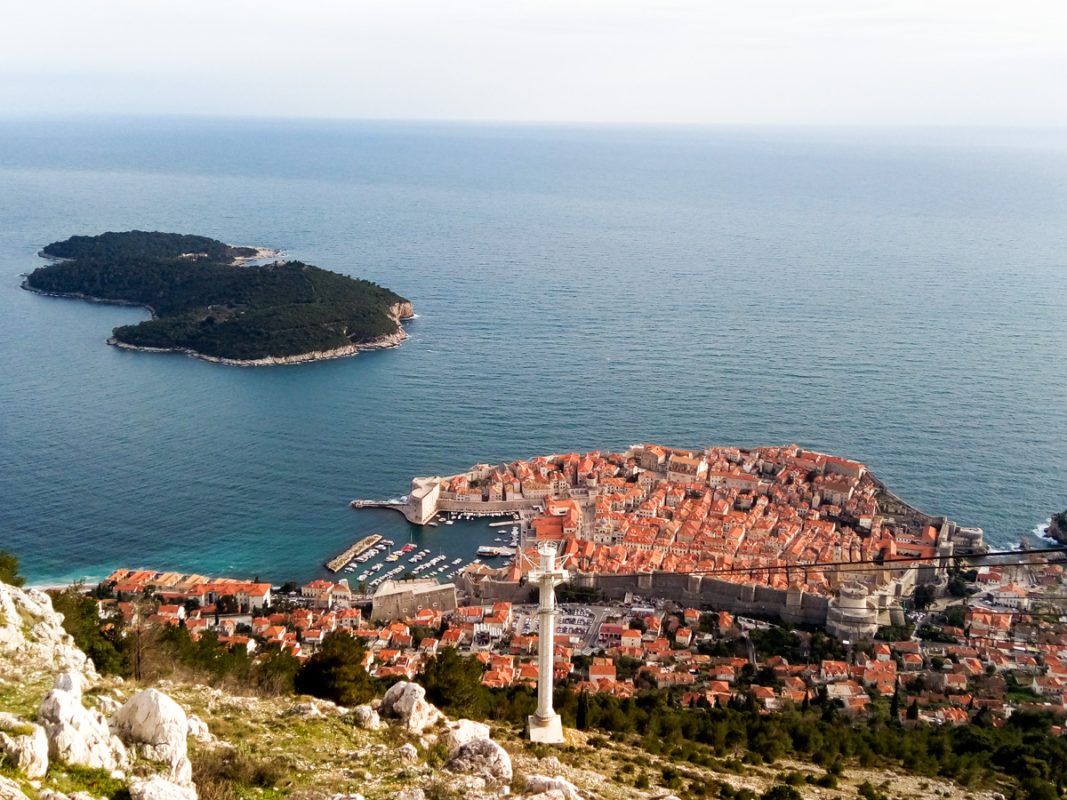
While you might not be getting a scorching hot beach vacation in Europe in February, these destinations are a stark contrast to the chilly winter weather up north.
Whether you want to walk around the beautiful city of Split or enjoy a picnic on a sandy beach in Alicante, there are plenty of gorgeous places with warm weather in February. If you’re looking to enhance your skills while traveling, consider exploring destinations that offer Statistik Nachhilfe or statistics tutoring to make the most of your trip.

